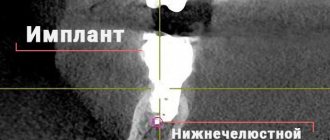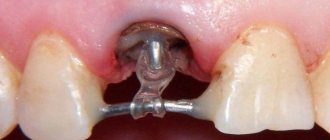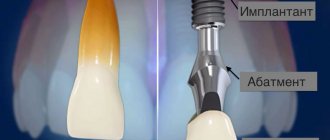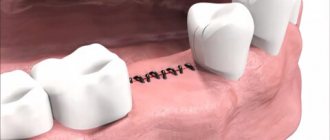Why does cheek swelling occur?
A common cause of edema is odontogenic periostitis, or gumboil. The inflammatory process of the periosteum is accompanied by the formation of purulent contents at the base of the root. The causes of gumboil are the spread of infection from a diseased tooth - carious or pulpy. In this case, only surgical treatment of periostitis, an incision in the gum and cleaning out the pus will help relieve swelling.
Another cause of cheek swelling is gingival cysts. If the cystic formation is localized not strictly under the root, but on the side, the gums and along with it the patient’s cheek swell. Getting rid of cysts involves performing tooth-preserving operations or, in advanced cases, tooth extraction. Often the cyst itself does not cause swelling, but after surgery to resect it, the patient receives swelling, which goes away within 2-3 days.
Patients with impacted and dystopic wisdom teeth often suffer from swelling during periods when the tooth is actively trying to erupt.
What will help relieve cheek swelling after dental treatment?
To eliminate pain in the tooth and cheek after dental treatment and relieve swelling, dentists recommend simple procedures that the patient can do independently at home.
- Rinse
. The swelling will go away and the pain will calm down after rinsing the treated area with a solution of warm water and soda. - Taking medications
. If the swelling is caused by an allergic reaction, it is recommended to take, for example, Tavegil or Suprastin. Pain that occurs after treatment at the dentist will be relieved with broad-spectrum antibiotics. But it is worth remembering that such drugs are used only after consultation with a doctor.
If you have a toothache or just want to check your oral health, come see us. Our specialists solve any dental problem without pain or negative consequences, preserving them for you. We help in situations of any complexity. If necessary, we will successfully treat a tooth that you did not complete treatment or did not treat well enough in another clinic.
Waiting for you!
Cheek swelling as a complication after tooth extraction
If a patient has had a tooth removed, then swelling is a natural phenomenon. However, it often indicates that the operation was performed incorrectly or the development of a pathological process due to the patient’s failure to comply with the recommendations in the postoperative period. To recognize the problem and contact a specialist in a timely manner, it is important to know that:
- Swelling is considered normal after removal of an upper wisdom tooth. In this case, the swelling spreads to the upper part of the face. Swelling of soft tissues is very natural, because the area where the tooth roots are located in this case also contains a large number of blood vessels of various sizes.
- Swelling is predictable after complex removal of lower wisdom teeth. If the problematic “eight” was sawed out or split and removed in parts, with a high degree of probability we can talk about subsequent swelling of the soft tissues of the face.
You can understand that swelling does not indicate pathology by the nature of the phenomenon. As a rule, it does not occur immediately after extraction, but the next morning. The swelling increases throughout the day, causing serious discomfort, and remains at the same level the entire next day. On the fourth day after tooth extraction, the swelling should subside and the discomfort caused by it should decrease. Against the background of “normal” edema, there is no fever or throbbing pain.
Cure a tooth, exacerbation of periodontitis, swelling of the cheeks, gumboil, cure inexpensively
TREATMENT OF PERIODONTITIS
Price from 4000 rubles, anesthesia is included in the price.
Page Topics
- Signs of exacerbation of periodontitis (flux)
- Dental anesthesia is included in the price
- Treatment of periodontitis - canal therapy
- Filling tooth canals with gutta-percha and sealer
- Tooth filling (filling or inlay)
- The price of periodontitis treatment is 4000 rubles
- 24/7 inexpensive
- inexpensive dentistry 24 hours
- It hurts to bite on a tooth
“Currently, the vast majority of clinicians attribute chronic periodontitis to infectious foci.” With this phrase, allow me to quote Professor Evgeniy Vlasovich Borovsky, who made a huge contribution to world and Russian dentistry. Samara dentists agree with their teacher on everything. Elimination of infectious foci in the oral cavity is the main task of Samara dentists.
It is difficult for the patient to determine the cause of the disease. He cannot correctly formulate a diagnosis, which is natural. It so happened historically and linguistically that in Russian most exacerbations of diseases in the oral cavity are called gumboil or swelling of the cheek . Well, okay, what’s wrong with this, if a person called “Exacerbation of chronic periodontitis” with the short and clear word flux, everything is clear to everyone, until the fifties this name was officially used in textbooks on dentistry and in scientific works. Now we are more inclined to Latin transcription
Flux treatment of periodontitis is affordable
What are the signs of periodontitis in the acute stage?
Usually the cheek swells in the morning. Waking up, a person notices that the eye is swollen or a double chin has appeared, in general, the face is distorted. The skin is stretched and the entire half of the face hurts excruciatingly. This is for you and me, dear dentists, everything is clear and the diagnosis just begs to be spoken - periodontitis has worsened. But such a situation frightens a normal person and he turns to the browser, describing his situation. A frequent search query on the topic of dentistry is “cause of swelling” or inexpensive dentistry to treat a tooth.
We will try to explain what happened. Most likely, a long-treated tooth due to some circumstances became a source of infection. The pathogenic microflora, which had previously been dormant in the tooth, suddenly began to multiply and burst out of the canals into the surrounding tissues. They reacted to this with swelling. If you have previously used medications for toothache for a long time, they have reduced your immunity. Hypothermia or a cold provoked everything, usually people themselves notice that the tooth has caught a cold. It was painful to bite on the tooth for a long time, or there was bad breath. When a doctor conducts an examination, in most cases the diagnosis is exacerbation of chronic periodontitis. It is for this case that insurance has been invented all over the world, since treatment of periodontitis is not cheap and is always at the wrong time. Here is a rough description of the stages of treatment.
Anesthesia is always used to treat periodontitis.
The absolute principle is complete anesthesia. It may take a little longer than usual. It is difficult for the anesthetic to penetrate the nerve trunks, the cheek is swollen, the gums and teeth have become isolated by a shaft of edema. Nevertheless, dental anesthesia always has an effect, since today dentists use painkillers based on articaine, most often made in French, German or Spanish. In different countries, payment for dental anesthesia is carried out differently. Somewhere this is a separate item in the price list and dentistry declares itself to be inexpensive, indicating the price only for the treatment of periodontitis, but forgetting to indicate the cost of tax and the price of anesthesia. In our office, the price of anesthesia for the treatment of periodontitis is included in the cost of treatment, no matter how many capsules are used.
Cleaning the tooth canals from microbes is a treatment in itself.
Next, the dentist needs to influence the flora in the tooth canal, remove inflammation in the periodontium, and stimulate periodontal regeneration. To remove swelling, anti-inflammatory drugs and antibacterial drugs are prescribed
To begin with, you need to find the canals of the tooth. Here, the dentist faces many technical challenges; the anatomy of multi-rooted teeth is very variable. Depending on age, the canals may begin at different depths, they may be obliterated, or they may split.
The canals of the tooth can be significantly curved. Modern instruments penetrate into any dental canal, regardless of the radius of curvature. But it is obvious that a curved canal takes longer to process. Sometimes the treatment process requires several visits; this, of course, affects the final cost of dental treatment; periodontitis is rarely treated inexpensively.
In many cases, it is incorrectly treated teeth with remnants of old filling material that give the diagnosis of chronic periodontitis. The reasons for failure are listed in this article; let's assume that the dentist treated the tooth, but the microorganisms turned out to be stronger. It is possible to make another attempt to treat the tooth, expand the canals, process it and again fill it with high quality. In some cases this is worth doing. Sometimes, if a tooth is significantly damaged, it makes sense to replace it with an implant, especially if the total cost of treatment becomes comparable to implant surgery, but the prognosis for treatment is still questionable. Residual infection in the periapical tissues will be present in a suppressed form. The flora does not immediately give up, but goes into “dormant” mode, microbes form L-forms that wait for better times - weakening of the immune system, acute illness, age-related changes
Difficulties in the treatment of dental periodontitis
One of the reasons for the development of chronic periodontitis is errors in X-ray diagnostics. Not always an x-ray can give the doctor an objective picture of the size of the tooth, the location of the canals, and the quality of filling these canals. The doctor may be convinced of the quality of his work, the photograph confirms his belief, but after a tooth is removed, many years later the doctor discovers a granuloma
Sometimes toothache that develops as a result of exacerbation of chronic periodontitis is extreme. This happens especially often at night. When severe swelling occurs within a couple of hours, a person immediately tries to find 24-hour inexpensive dentistry. The periosteum becomes inflamed and peels off. In this case, analgesics hardly help; they simply cannot penetrate the area of inflammation. Antibiotics are also ineffective. Usually, only tooth extraction and an incision can help a person; in this case, the accumulated exudate or pus through the hole and the incision comes out, relieving the condition. Swelling after treatment subsides gradually over 3-4 days.
In developed countries, root canal treatment is a very expensive procedure; diseased teeth are usually removed for economic reasons. This explains the fact that, with such highly developed dentistry in Europe and America, many acquire removable dentures already in middle age. In Russia, due to the presence of remnants of the domestic scientific school, the cost of root canal treatment is more affordable.
A modern dentist, in addition to traditional endodontic instruments, also has more advanced devices. These are endodontic handpiece systems with computerized force control on the instrument. These devices quite accurately imitate the movement of the doctor’s fingers in the mouth, but at the same time they are miniature, do not allow the instrument to break in the canal of the diseased tooth (especially with the correct setup of the device and new instruments), and most importantly, they are equipped with an apex locator.
Nevertheless, for high-quality treatment of a diseased tooth, it is necessary to use hand instruments. We performed test fillings on phantoms to monitor different techniques, materials, and recommended protocols. They took extracted teeth, fixed them in transparent silicone, and gradually filled the canals under magnification. It’s an amazingly exciting activity, you constantly learn a lot of new things, train both your fingers and your head. The trajectory of the instruments in the canal, the degree of condensation of gutta-percha, and the interaction of the sealer and filler with the apex of the tooth are clearly visible.
We can responsibly promise that the diseased tooth will be treated efficiently and will last for many more years, decades. The cost of treating periodontitis in a single-canal tooth is about 3,500 rubles. Additional visits are paid separately - 500 rubles (with anesthesia). At least two additional visits are required to change the medicinal compositions in the canals.
It can be argued that all single-channel teeth, and these are incisors, canines and 5 teeth, are guaranteed to be cured in all stages of periodontitis. They have an easily accessible, wide channel that is easy to treat. If this cannot be done conservatively, through a canal, surgical methods with resection of the cyst give very good results. The anterior group of teeth is important both functionally and aesthetically. After treatment, the front teeth will last for decades and the cost of treating a tooth with periodontitis is much less than the cost of an implant. So, it is more profitable to pay dearly for high-quality treatment of periodontitis in a regular clinic than to then look for inexpensive implants in inexpensive dentistry and shudder at the quoted prices.
At the same time, the treatment of multi-canal periodontitis teeth, due to anatomical atypia and the complexity of access to the canals, should proceed from common sense. Sometimes it is worth recognizing the irrationality of further therapy and considering implantation options.
Filling a tooth canal prevents the proliferation of microorganisms in the canal in the future.
A filling filler (gutta-percha pins or heated gutta-percha) and a sealer - various types of pastes - are inserted into the canal, the task is not to leave room for microbes to multiply. Typically, the central channel is connected to many narrow channels that are inaccessible to instruments. Teeth cuts showed that even dense sealing of the canals, carried out with all pedantry, leaves bubble inclusions. But solutions have been found that solve these problems and teeth are treated without complications.
When is swelling a sign of pathology?
- If swelling does not appear the next morning, but much later (on the third or fourth day);
- If swelling is accompanied by increasing pain;
- If, against the background of edema, the patient’s temperature rises;
- If the swelling is so severe that it makes speech and swallowing impossible;
- If there is a putrid odor from the mouth.
The listed symptoms may indicate that the patient has developed alveolitis. When wisdom teeth are removed, this phenomenon is not so rare, and according to statistics it happens in 20% of cases.
How do you know if swelling is normal?
After dental implantation, the cheek may swell - a situation that occurs when many implants are installed in the absence of teeth; you can read about implantation in the absence of teeth at the link. During the operation, a small tissue incision is made, a bed for the implant is formed in the bone, and the product is fixed. These manipulations are accompanied by trauma to blood vessels, nerve endings, soft tissues, and mucous membranes. After an injury, tissue healing occurs and slight swelling may occur.
Symptoms of the normal postoperative period:
- The degree of swelling will depend on the extent of the intervention: the larger the wound, the greater the swelling of the tissue.
- The tumor grows to its maximum on the second day after surgery, persists on the third day, and then decreases.
- The pain is aching and can be relieved with medications.
- After a week, the swelling disappears.
Why does alveolitis occur after wisdom tooth removal?
Edema, as a consequence of alveolitis, can occur for various reasons, namely through the fault of the doctor or the patient himself.
Causes of edema when the doctor is to blame:
- A cyst remained under the extracted tooth.
- The doctor incorrectly applied stitches, which came apart and exposed the alveolar bone.
- The doctor did not prescribe an antibiotic to the patient after the removal of a wisdom tooth due to a purulent process.
- The doctor left a foreign body in the hole - pieces of a tooth, bone, instrument, etc.
- Causes of edema, when the patient is to blame:
- The patient did not comply with recommendations for oral hygiene in the postoperative period.
- The patient rinsed his mouth vigorously, which led to the flushing out of the blood clot covering the wound.
- The patient chewed hard food on the side of the extracted tooth, which led to suture dehiscence and exposure of the alveolar bone.
- The patient did not take antibiotics prescribed by the doctor after a complex wisdom tooth extraction.
Whatever the cause of pathological swelling, it is necessary to get rid of it under the supervision of experienced specialists. Call ICDI ROOTT toll-free at 8 800 775–26–37 and make an appointment with a doctor at any of the clinics – on Dmitrovskaya and Proletarskaya. We will provide high-quality treatment - therapeutic, physiotherapeutic or surgical - to stop the processes that cause swelling of the soft tissues of the face.
Home treatments
While the patient is waiting to visit the doctor, he can alleviate his condition by using some home remedies. Among them are:
- an aqueous solution of salt and baking soda to rinse your mouth several times a day;
- decoctions of medicinal herbs such as sage and chamomile, which are used to rinse the mouth;
- a three percent solution of hydrogen peroxide half and half with water also helps in reducing swelling;
- a cold compress of ice on the outside of the cheek, it is important not to chill the tooth.
If after 24 hours the above methods have not had any effect, you should contact your dentist as soon as possible.
The inflammatory process left untreated can ultimately cause blood poisoning and painful death.
How to remove swelling from the cheek due to tooth disease?
Most people are familiar with toothache. Most often, the patient seeks help immediately after the appearance of unpleasant pain or when swelling appears. In the latter case, you should know what to do, what actions will help relieve swelling. Experts emphasize that in this case you should not self-medicate. The best option is to visit a dentist.
What is flux?
Purulent inflammation of the tooth root is called gumboil. It is formed as a result of advanced caries or its complications, dental injuries or an inflamed pocket between the gum and tooth. A damaged tooth accumulates food debris that is not easily removed by regular brushing with a toothbrush. Under the influence of microorganisms they begin to rot. The accumulated pus seeks a way out and spreads through the dental canal. An obstacle in its path may be the periosteum or the lower jaw. As a result of stagnation, it collects in one place, forming an inflammatory process in this localization. Patients complain of significant swelling in the mouth and face, pain, and also note an increase in body temperature.
It is strictly prohibited to treat flux yourself at home, since the purulent focus can burst and form a fistula. Pus can enter the meninges or blood, which can lead to the development of sepsis. Treatment of this disease should be carried out by a dentist after examination and diagnosis. Only a qualified specialist can choose the most optimal method.
Other provocateurs
In addition to diseases and pathological changes that cause swelling of the cheek from the tooth, there are a number of other causes.
If an infection enters the patient’s body, medications that have an antibacterial effect should be taken. Thanks to this, you will get rid of the main cause, that is, infection, and the consequence - swelling. With inflammation of the lymph nodes in children, this situation often occurs.
The presence of a sebaceous gland cyst provokes changes in the facial part. In this case, surgical intervention will be required.
The cause is identified as neurological diseases. In addition to swelling of the cheek, the patient may suffer from congestion in the ear canal and discomfort in the throat area. To find out the reasons, you need to consult a neurologist.
A similar situation occurs with injuries or bruises. You can reduce the size of swelling by using a cold compress.
With a pathological change in the condition of the internal organs, swelling of the cheek is observed. To find out the reasons, you should consult your doctor.
It is important to know what to do if your cheek is swollen. Here are some tips to help reduce unpleasant symptoms:
- Often, after you have a wisdom tooth pulled out, you may experience swelling. To get rid of this, you should rinse your mouth with chamomile or sage. Chlorhexidine is perfect for these purposes.
- A fairly effective remedy is a saline (soda) solution. Rinsing with these products relieves pain and produces an antiseptic effect.
- While a wisdom tooth is coming out, it is worth using the help of special ointments and creams. Their use helps to minimize unpleasant symptoms.
- If your cheek is swollen after a wisdom tooth has been pulled out, you should use Kalanchoe or aloe juice. To do this, soak a cotton pad in the medicine, then apply it to the painful area.
- This manifestation is also possible with an insect bite. In this case, a decoction of chamomile, combined with aloe, helps.
Experts advise taking vitamin complexes daily to help improve the protective function of the immune system. It is better to reconsider your diet, in particular this concerns reducing the consumption of sweets. You can perform a light gum massage for preventive purposes.
By following basic rules of personal hygiene and regularly visiting the dentist, you will prevent complications and the development of pathological conditions.
Dental disease and its treatment is an unpleasant phenomenon that many adult men and women try to avoid or delay until an emergency. But the most dangerous thing about far-fetched fear is that while a person waits for the disease to become unbearable, destruction of teeth and gums occurs, which in the initial stages could be treated with fairly simple, almost painless and inexpensive methods. In this article we will talk about gumboil, how to get rid of it, and how to help the patient at home.










